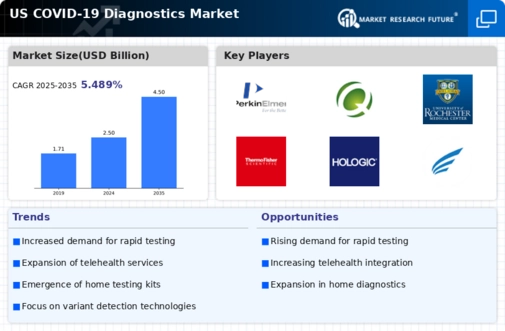The competitive landscape of the US COVID-19 Diagnostics Market reveals a dynamic environment crucial for healthcare infrastructure and response, particularly in the wake of the pandemic. This market is characterized by rapid technological advancements, a surge in demand for innovative diagnostics solutions, and an expansion of testing capabilities. Numerous players are vying for market share, employing diverse strategies ranging from partnerships and collaborations to mergers and acquisitions. Companies must navigate regulatory challenges while addressing the evolving needs of healthcare providers and testing facilities.
The intense competition is driven by a combination of factors, including the need for rapid testing, accuracy, and cost-effectiveness, pushing firms to consistently enhance their offerings and maintain regulatory compliance.
PerkinElmer has established a significant presence in the US COVID-19 Diagnostics Market, benefiting from its comprehensive portfolio that encompasses a range of testing solutions, including molecular diagnostics and serological tests. The company's expertise in sample collection and analysis has enabled it to develop rapid testing kits that meet the growing demands of healthcare providers. PerkinElmer's strength lies in its advanced technology and a robust supply chain that allows for effective distribution across various healthcare settings. Their commitment to innovation is evident in their research and development efforts, which have produced high-performance testing solutions tailored to detecting COVID-19 variants.
By leveraging its established infrastructure and extensive experience in the diagnostics field, PerkinElmer has positioned itself as a key player in the market amidst fierce competition.
Yangzhou Eversky Medical Technology is carving a niche for itself in the US COVID-19 Diagnostics Market with a focus on producing high-quality test kits that are both reliable and efficient. The company offers a range of rapid antigen tests and RT-PCR kits designed specifically for COVID-19 detection, which align with the needs of healthcare institutions in the United States. Yangzhou Eversky Medical Technology benefits from its strong manufacturing capabilities and expertise in medical diagnostics, allowing it to quickly respond to fluctuating market demands.
In recent years, the company has pursued strategic partnerships and collaborations to enhance its product offerings, strengthening its position in the market. Furthermore, its commitment to quality assurance and regulatory compliance ensures that its products meet the rigorous standards required in the US, contributing to the company's strengths and solidifying its reputation among healthcare providers seeking effective diagnostic solutions.

















